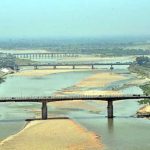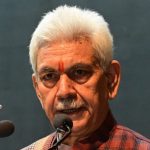Many interpretations about the name of Jammu have been given by various chroniclers and historians .Origin of the name Jammu of the region has been mainly ascribed to the ruler Jambulochan, the descendant of the house of Raghu and others hold that it acquired the name due to the fruit Jamun that is found in abundance in the region. But going through the historical records and descriptions of the historians.Jammu is a word that means a sect of Brahmins who got displaced from Kashmir and settled in the region.The trail they used has been referred to as Jammu Marg.Thus it establishes that Jammu is not a modern conception as a place but it has its continuity inherent in the history of India and its epics that have shaped the national consciousness. This Mahabharata verse establishes that Jammu acquired a sacred place in the religious texts. The present day pilgrimage to Shree Mata Viashno Devi is the continuity of the age old traditions that has gained momentum with developmental initiatives. But the essence remains the same intent of pilgrimage. The religiosity of the society is visible in the rituals and food habits of the Duggar land. As every activity is blended with some sort of religious overtones that depict the culture.Thus it establishes that Jammu is not a modern conception as a place but it has its continuity inherent in the history of India and its epics that have shaped the national consciousness. This Mahabharata verse establishes that Jammu acquired a sacred place in the religious texts. The present day pilgrimage to Shree Mata Vaishno Devi is the continuity of the age-old traditions that has gained momentum with developmental initiatives. But the essence remains the same intent of pilgrimage. The religiosity of the society is visible in the rituals and food habits of the Duggar land. As every activity is blended with some sort of religious overtones that depict the culture.Jammu and Kashmir may appear to many as the un natural wedlock but the cultural aspect when viewed in the prism of the Indian philosophical tradition makes it a complete cultural unit.It can be argued that Kashmir region of the state has the tradition of the Kul Devis in each family. Kashmiri Pandits have the tradition of paying obeisance to their Ishth Devis like Jwala,Sharika and Kheer Bhawani,venerating the feminine aspect of the nature.But Jammu region has the tradition of venerating the Kul Devtas like Kali Veer,Sidh Goriya, Baba Bhoto etc. No doubt the Shakti Peeths hold immense significance.If viewed in a comprehensive manner of the religious tradition, it can be said that state of Jammu and Kashmir fructifies the Shaiva philosophy in which Shakti is the energy consciousness of the Lord and masculine potential manifests in the kinetic action of the feminity. One region acting as the potential energy and another as the kinetic energy of the supreme.There are many references in the Harivansha that depict Jammu as in important pilgrimage centre of India having great religious significance.It has to be mentioned here that in texts like Rajatarangini name of the region is mentioned as Dvigrata, which may have corrupted later to Durgara or Duggar. Historians have established in their findings with the help of archaeologists that Chamba copper plate inscriptions refer to Jammu, when they come across the reference ‘the Lord of Durgara’. These inscriptions reveal the chivalry of the people of the land who had military interests from the evolutionary stages of the region. It has been referred to as the tribe that existed from the time of Gupta or pre-Gupta age. But 11th century inscriptions in the above-mentioned Chamba copper plates issued by Soma Varman situate Jammu in the antiquity of the cultural tradition. These inscriptions mention the territorial ambitions of the Dogras across the Shivaliks into the Chamba. Not only that Dogras find mention in the history while taking part in the military campaigns with their kinsmen known as Balourias. It is a recorded fact that Kangra valley has been in the sub ordination of the Jammu’s over lordship.It must be borne in mind that city of the region is also known by the name Jammu. Amir Timur attacked Jammu in 1398-99 and thus, we find that its name is mentioned in Malfuzat-i-Timuri and the Zafarnama. Rajatarangini of Kalhana does not mention the region by the name Jammu, the reason being that capital of the region was Bahu and even changed for some time to Babbapura also known as Babor. It is located on the Dhar-Udhampur road and excavations done by ASI reveal the importance of this place.This can be said with ease that Jammu was a politically conscious and culturally adaptable region as the shifting of the capital gives an indication that its rulers ruled with ease that suited their administration. This shifting of capital from time to time would have given chance to develop the locale as per the situation and natural resources. Travelling in the interior of Jammu region exposes a person to the cultural life that has diversity from district to district. No doubt the language spoken is Dogri but its dialect and intonation changes with the incorporation of words for the same subject differently.It must be said that the cultural evolution of Jammu has taken place by interaction with the various people and closeness with the people in the adjoining planes makes Jammu and interesting society.Evaluation of the historical records and studies carried out by the contemporary scholars brings to the fore the acumen of the ruling clans to develop relations with the adjoining hill states to foster good trading and cultural relations. Jammu has been close to Punjab plains and Kangra –Chamba belt as far its customs, dialect and other symbols of attire are concerned but it can’t be denied that it enjoyed political relations with the rulers of Kashmir when alliances were sought to defend the territory of valley from outsiders.
Jammu’s Evolution

Sign Up For Daily Newsletter
Be keep up! Get the latest breaking news delivered straight to your inbox.
By signing up, you agree to our Terms of Use and acknowledge the data practices in our Privacy Policy. You may unsubscribe at any time.
Leave a Comment Leave a Comment
Stay Connected
Latest News
Recent Posts
- GBHSS Nowpora Srinagar observes Teachers’ Day
- Young Female Cricketer Kanchan Kumari Dies in Tragic Accident; YSS Directorate Mourns
- “Daily Parcel-train from Budgam to New Delhi will bring huge relief to Apple growers”: LG Sinha
- “Loading of 2 Parcel Vans Carrying Apples from Budgam to Delhi Begins Today”: Ashwini Vaishnaw
- Nepal Army extends curfew in Kathmandu, other districts; essential services allowed for limited hours







